
Healing Fingers and Toes: 1 2 3 <<First
Treating Fingers and Toes In the Golden Age of Piracy, Page 3
Dislocated Fingers and Toes
French military surgeon Ambroise Paré explains that fingers and toes "may bee four several
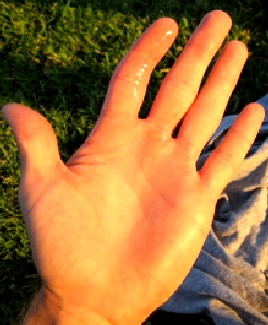
Photo: R. Moore - Dislocated Index Finger
waies dislocated, inwardly, outwardly, and at each side."1 Sea surgeon John Atkins adds some signs that a finger has been dislocated: "Forward the Flexors [muscles that bend the fingers] will be stretched, backward the Extensors [muscles that contract the fingers], and the Disparity is easily seen and felt."2
Both Paré and Atkins give similar advice for repairing a dislocated digit. When fixing dislocated fingers, Paré provides the most detailed information on the process. He suggests that the surgeon "hold them straight upon a table, and so put [them] into joint again. For thus they may bee easily restored, by reason their sockets are not deep, and their joints are shorter, and ligaments less strong."3
Atkins recommends medicating the dislocated fingers, recommending that they "require... an Embrocation [balm to relieve pain] and Emplaister [plaster to hold the digit in place], suitable Rowling and Repose."4
Paré's advice for fixing dislocated toes is basically the same as his advice for fingers, although he adds that the surgeon should "binde them up as is fitting"5 so they don't move around while healing. Although he doesn't say so, Paré almost certainly binds the fingers in place as well so that they would be kept stationary while healing. He further advises that "when any thing is dislocated in the foot, the patient must keep his bed; but when any thing is amiss in the hand, hee must carrie it in a scarf."6 Here again we see concern about keeping the digits stationary.
The healing time is fairly short. Paré says that after they are put back in place, dislocated digits will strengthen and be healed in about twelve days.7
1 Ambroise Paré, The Workes of that Famous Chirurgion Ambrose Parey, 1649, p. 389; 2 John Atkins, The Navy Surgeon, 1742, p. 109; 3 Paré, p. 397; 4 Atkins, p. 109-10; 5,6 Paré, p. 397; 7 Paré, p. 389
Digit Amputation
The digit operation with the broadest support in golden age of piracy era medical books was amputation of the fingers and/or toes. While this operation was not nearly as complex as full limb amputation, it still had some interesting features.
Sea surgeon John Moyle rather succinctly explains the need for digit amputation. "Sometimes a Finger, or a Toe, happens to be quasht to peeces, bone and all, so that there is no healing of it, but it must be taken off; or it will quickly Gangreen."1 Sea surgeon John Atkins
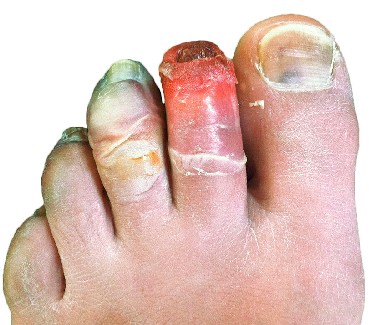
Photo: Dr. S. Fatz - Frostbitten Toes, 12 Days After Being Frostbitten
identifies a number of other problems requiring amputation of finger and toes: "Painful Corns, Fractures, Felons [paronychia or foot rot], Thorns, or Splints [splinters], running deep into the Ends of the Fingers, (under or on the Sides of the Nails) will often by their acute Pain, bring on sudden great Inflammation and Fluxion; sometimes rot the Bone without any Sign of a Mortification outwardly."2
Some cases of frostbite of the toes are also mentioned by period authors, with the recommendation being to amputate these digits. Although many people associate pirates with the warm Caribbean, they also traveled up and down the North American coast, recruiting fisherman from places in the far north like Nova Scotia, so this is not as unlikely as it may first seem.
Sir Henry Mervyn, who was aboard the Vanguard at Plymouth in December 1627 lamented that "the men lodge on bare decks... their condition miserable beyond relation; many are so naked and exposed to the weather in doing their duties [so] that their toes and feet miserably rot and fall away piecemeal, being mortified with extreme cold"3.
Naval surgeon Hugh Ryder cited a case study concerning a ship bound for the West Indies whose Master's servant "by extremity of cold Weather got a Mortification of both his Feet; being desired I went down to Limehouse to see him, and feeling on his Feet, several of his Toes came off in my hand."4
1 John Moyle, The Sea Chirurgeon, 1693, p. 95; 2 John Atkins, The Navy Surgeon, 1742, p. 163; 3 Kevin Brown, Poxed and Scurvied: The Story of Sickness and Health at Sea, 2011, p. 31; 4 Hugh Ryder, New Practical Observations in Surgery Containing Divers Remarkable Cases and Cures, p. 69;
Instruments
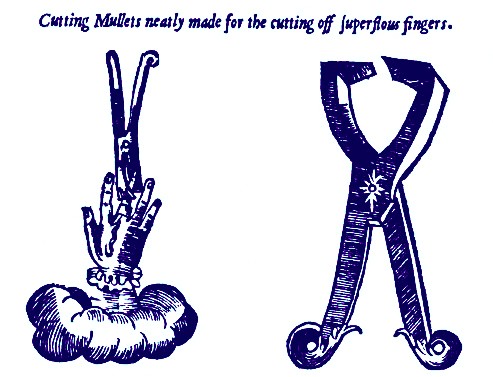
Digit Nippers from The Workes of That Famous Chirurgeon
Ambrose Parey, p. 418 (1649)
Perhaps because the process of amputation was so much simpler than limb amputation, there was quite a bit of focus on the instruments used to perform the operation in the period surgical books. There were essentially three types of tool used to remove fingers and toes during the golden age of piracy: the saw, the chisel and the nippers.
The vast majority of the evidence from surgeon's books at this time suggest that the nippers and chisel were the most widely used tool at this time. When discussing the amputation of superfluous fingers, French surgeon Ambroise Paré noted that they could be removed "with the cutting mullets hereafter described"1. (The image Paré mentions can be seen at left.)
Sea surgeon John Woodall recommends both, explaining that the 'dismembering Nipper' and
'Mallet and Chizell' were "for amputation chiefly, and are appointed to the fingers and toes"2. Woodall goes on to explain that "that they are good necessaries upon occasions in the Surgeons Chest being kept well."3 He adds another, very interesting statement: "Nevertheless in want of such [instruments] at sea, the ship-Carpenter for a neede can always furnish the Surgeon
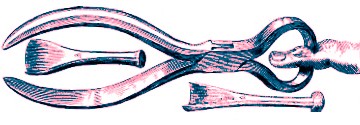
John Woodall's Amputation Chisels and Nippers (1639)
in a short warning, and therefore they may as well be forborne as any other I know in the Chest, if allowance [space] grow scant."4 This should come as no surprise when looking at images of these tools.
The hammer and chisel get support from a variety of surgeons. Sea surgeon John Moyle advised "if a Finger or Toe [needs to be amputated], you extirpate it with your Chizel and Mallet."5 While writing about the history of surgical instruments, John Kirkup explained that "Woodall and [German physician Johannes] Scultetus recommended amputation by instantaneous severance of fingers, toes, and even whole hands by means of a heavy chisel and wooden mallet."5 Scultetus shows an example in his text, with a thumb being removed with nippers.
German military surgeon William Fabry eschews the chisel, recommending that the surgeon carry "a little Saw for the dismembring Fingers, and Toes; it not becoming a Rational Chirurgeon to separate them with Chissels"6.
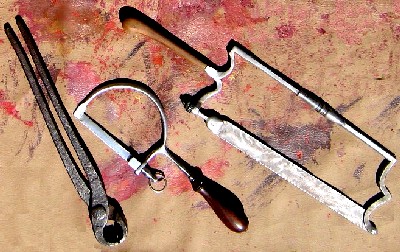
Finger Amputation Nippers & Saw with Limb Amputation Saw for Comparison
The idea of the saw being used in favor of the more rudimentary nippers and chisels seems to fascinate historian John Kirkup. So much so that he repeatedly comments on this point in his book.
Kirkup explains that while the chisel was used "to diminish pre-operative pain by instantaneous section, this method lacked sufficient power and speed for major amputations. Because the bones of the tibia and fibula splintered badly and because soft tissues were torn rather than incised, this form of surgical dismembering was abandoned in the early eighteenth century.7
Kirkup elsewhere explains, "For hand amputation, Fabry von Hilden considered this method cruel and unworthy of a rational surgeon, as nerves and tendons were contused rather than sectioned cleanly.... He then rejected large bonecutting and trimming forceps, for not only did they fail to divide nerves and tendons satisfactorily but also they shattered bone."8
Kirkup notes that Matthias Gottfried Purman was "one of the last authors to illustrate an amputation chisel for fingers and toes" in 1706. Yet sea surgeon John Atkins employed this method long after that, as noted in the 1742 edition of his book. "I have frequently on all these Occasions, taken off the Joints of Fingers and Toes, done at one Stroke with the Chissel, in the Joint of the second or third Phalanx; because [it is] less apt to splinter [when the bone is rotten]."9 If anything, Fabry's comment about the preferability of the saw seems out of place.
1 Ambroise Paré, The Workes of that Famous Chirurgion Ambrose Parey, 1649, p. 418; 2,3,4 John Woodall, the surgions mate, 1617, p. 8; 5 John Moyle, Abstractum Chirurgæ Marinæ, 1686, p. 88; 4 John Kirkup, The Evolution of Surgical Instruments; An Illustrated History from Ancient Time to the Twentieth Century, 2005, p. 52; 6 Guliielm. Fabritius Hildanus aka William Fabry, His Experiments in Chyrurgerie, p. 26; 7 Kirkup, p. 87; 8 Kirkup, p. 392; 9 John Atkins, The Navy Surgeon, 1742, p. 103
Digit Amputation Procedure
The digit amputation procedure is quite simple when compared to the amputations performed higher up on the limbs. This is largely due to the tools used and the small amount of flesh covering the bones of the fingers and toes. Both sea surgeons John Moyle and John Atkins explain the procedure. The fact that two of the three sea surgeons from around this time period go into detail on the procedure hints at the likelihood that digit amputations would have to be performed on a ship at some point.
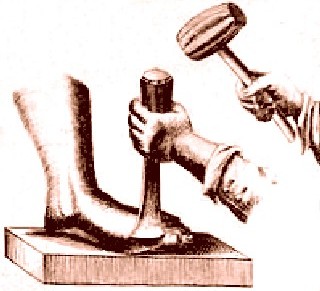
Toe Amputation, From Lorenz Heister's A General
System of Surgery (1750)
Unlike the extensive preparation that took place when amputating a limb, digit amputation went straight into the removal of the digit. Moyle gives a fairly thorough description of the process:
Place the Part even upon a small Block, that hath something of a Prominence on its upper Part whereon the Digitus [finger or toe] lyeth, so that it may not lye hollow, for fear of shattering the Bone; And let the Digitus be held close to.
Then with your sharp Chizel, and weighty Mallet, strike it off at one Blow. You need not divide the Flesh about, for a Keen Chizel doth divide all both Flesh and Bone together.1
Atkins likewise recommends uses the chisel, removing the digit "at one Stroke", preferring to make his cut at a joint as mention in the previous section.2 (This would help prevent the bone from shattering.)
Once the end of the finger or toe was cut off, Moyle applied "a small Pellet of dry lint... to the end of the Bone, and another Pledgit [a compress, often made of lint] armed with Pulv. Galen. [a restrictive powder to stop the bleeding,
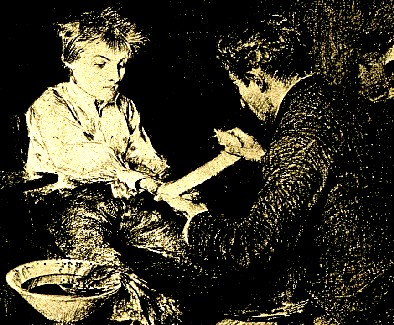
Artist: Pascale-Adolphe-Jean Dagnan-Bouveret
Bandaging a Boy's Hand With Roller Bandage, Wellcome Images (19th c.)
made with barberries] either dry or mixt Cum. Alb. Ov. [with egg white] and on that a Compress, and so make Bandage."3
Unlike Moyle, Atkins uses Oil of Turpentine to stop the bleeding and then applies compresses soaked in a 'Digestive' (medicine to promote the growth of healthy flesh) covered with "a little thick cross Cloth, a Rowler to keep it on, and a Flannel Cap over all; especially in cold Weather, to keep the Stump warm"4.
While Atkins' procedure ends there, Moyle goes on to give advice on later dressings for the stump. He begins by putting 'a small Pellet dry' (probably made of lint) on the end and (similar to Atkins' first dressing) covers that with a compress soaked in turpentine, to which is added egg yolk and/or basillicum (an ointment with healing properties).
Moyle also smears the rest of the hand or foot with oil of roses and a plaster of diapalma, which were thought to help soothe and heal the stump.5 This dressing was to be applied every day until the wound was healed.
Once the wound healed, Moyle advised the use of an epulotic medicine to allow the stump to skin over. He insists that the surgeon "defend [the stump] from the Air all you can; to which end you may apply a warm Stupe [piece of absorbent cloth] wrung out of warm Wine, or Common Spirit of Wine [brandy]."6 He also warns that if the bone becomes infected (fouled), it must be exfoliated "with a little Pulv. Euphorbii on the small Pellet of Lint" before the wound is healed.7
1 John Moyle, The Sea Chirurgeon, 1693, p. 39; 2 John Atkins, The Navy Surgeon, 1742, p. 103; 3 Moyle, p. 39; 4 Atkins, p. 103; 5 Moyle, p. 39-40; 6,7 Moyle, p. 40
Dressing Accidental Digit Amputations
Sometimes a digit amputation occurred outside the surgeon's control and it was up to him to see that it healed. Surgeon Richard Wiseman discussed a method for dressing fingers and toes which 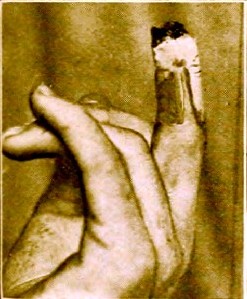
Finger Stump, Side, From Plastic Surgery;
Its Principles and Practice (1919)
had been accidentally sliced off. He discusses two such cases: one
where a horse 'snapt off' the end of a gentleman's finger and another where someone's toes and part of their foot were shot off.
The wounded foot appears to have been a fairly clean wound, because Wiseman only says that he "cut off the lacerated Parts smooth, but with care to save as much of the Foot with the Heel" as possible, this result "being much better than a wooden Leg."1 Presumably Wiseman dressed this wound in a manner similar to the case that follows, although he does not specify this.
For the horse-bitten finger, Wiseman dresses the stump with a digestive (wound healing) medicine mixed with warm oil of roses and plaster of diachalciteos. This plaster is basically the same as the one sea surgeon John Moyle advised in the previous section on amputating digits. Plasters of diachalciteos and diapalma only differ from one
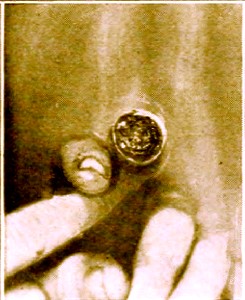
Finger Stump, Front, From Plastic Surgery;
Its Principles and Practice (1919)
another by one ingredient. Wiseman then rolled up the stump, replacing the dressings every two or three days.2
This case also had some interesting complications. Wiseman hints that the patient should have been bled and adhered to a diet which would encourage healing, although he doesn't give much more detail than that. Unfortunately, the patient wasn't bled and didn't follow the diet he was presumably prescribed, so his finger failed to heal. This resulted in and infection which Wisemqn identifies by "an undigested crude Ichor [watery, pungent discharge] dropping from it, and the Parts about [becoming] blistered"3.
To deal with this, Wiseman scarified the finger, which involves making a bunch of small incisions in it. This would have broken and drained the blisters as well as bled the finger. He then treated the scarified finger with oil of turpentine and mercury precipitate. The mercury would have burned away the infection and encouraged the growth of new flesh.
Wiseman then bandaged the wound, this time using basillicum ointment and plaster of diachalciteos to promote healing. When the infection healed, Wiseman turned back to oil of turpentine combined with the basillicum, bled the patient (presumably in the arm) and purged his stomach with senna infused in water. He then healed the stump with medicines like those discussed in the previous section for healing amputated fingers.4
1 Richard Wiseman, Of Wounds, Severall Chirurgicall Treatises, 1676, p. 451; 2,3,4 Wiseman, p. 361

